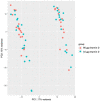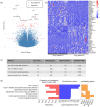High-Dose Vitamin D Supplementation Significantly Affects the Placental Transcriptome
- PMID: 38140291
- PMCID: PMC10745524
- DOI: 10.3390/nu15245032
High-Dose Vitamin D Supplementation Significantly Affects the Placental Transcriptome
Abstract
Vitamin D deficiency is a highly prevalent obstetrical concern associated with an increased risk of complications like pre-eclampsia, gestational diabetes, and growth retardation. Vitamin D status in pregnancy is also linked to long-term offspring health, e.g., the risk of obesity, metabolic disease, and neurodevelopmental problems. Despite the suspected role of vitamin D in placental diseases and fetal development, there is limited knowledge on the effect of vitamin D on placental function. Thus, we performed next-generation RNA sequencing, comparing the placental transcriptome from uncomplicated term pregnancies receiving the often-recommended dose of 10 µg vitamin D/day (n = 36) with pregnancies receiving 90 µg/day (n = 34) from late first trimester to delivery. Maternal vitamin D status in the first trimester was also considered. We found that signaling pathways related to cell adhesion, immune function, and neurodevelopment were affected, supporting that increased vitamin D supplementation benefits placental function in established pregnancies without severe vitamin D deficiency, also underlining the importance of vitamin D in brain development. Specific effects of the first trimester vitamin D status and offspring sex were also identified. Further studies are warranted, addressing the optimal vitamin status during pregnancy with a focus on organ-specific vitamin D needs in individual pregnancies.
Keywords: NGS; immune function; placenta; pregnancy; vitamin D.
Conflict of interest statement
The authors declare no conflicts of interest. The funders had no role in the design of the study; in the collection, analyses, or interpretation of the data; in the writing of the manuscript; or in the decision to publish the results.
Figures




Similar articles
-
Vitamin D insufficiency among Danish pregnant women-Prevalence and association with adverse obstetric outcomes and placental vitamin D metabolism.Acta Obstet Gynecol Scand. 2021 Mar;100(3):480-488. doi: 10.1111/aogs.14019. Epub 2021 Jan 12. Acta Obstet Gynecol Scand. 2021. PMID: 33030742
-
Vitamin D in pregnancy (GRAVITD) - a randomised controlled trial identifying associations and mechanisms linking maternal Vitamin D deficiency to placental dysfunction and adverse pregnancy outcomes - study protocol.BMC Pregnancy Childbirth. 2023 Mar 15;23(1):177. doi: 10.1186/s12884-023-05484-x. BMC Pregnancy Childbirth. 2023. PMID: 36922777 Free PMC article.
-
Maternal vitamin D sufficiency and reduced placental gene expression in angiogenic biomarkers related to comorbidities of pregnancy.J Steroid Biochem Mol Biol. 2017 Oct;173:273-279. doi: 10.1016/j.jsbmb.2017.02.003. Epub 2017 Feb 13. J Steroid Biochem Mol Biol. 2017. PMID: 28216083 Free PMC article. Clinical Trial.
-
Influence of mineral and vitamin supplements on pregnancy outcome.Eur J Obstet Gynecol Reprod Biol. 2012 Oct;164(2):127-32. doi: 10.1016/j.ejogrb.2012.06.020. Epub 2012 Jul 6. Eur J Obstet Gynecol Reprod Biol. 2012. PMID: 22771225 Review.
-
Effects of micronutrients on placental function: evidence from clinical studies to animal models.Reproduction. 2018 Sep;156(3):R69-R82. doi: 10.1530/REP-18-0130. Epub 2018 May 29. Reproduction. 2018. PMID: 29844225 Review.
Cited by
-
Insulin aspart plus high-dose vitamin D supplementation for gestational diabetes mellitus: analysis of efficacy and risk factors for maternal and infant outcomes.Am J Transl Res. 2024 Aug 15;16(8):4200-4207. doi: 10.62347/PKAY4284. eCollection 2024. Am J Transl Res. 2024. PMID: 39262735 Free PMC article.
-
Associations Between Prenatal Vitamin D and Placental Gene Expression.J Nutr. 2024 Dec;154(12):3603-3614. doi: 10.1016/j.tjnut.2024.10.019. Epub 2024 Oct 12. J Nutr. 2024. PMID: 39401684 Free PMC article.
-
Placental and cord serum inflammatory cytokines and children's domain-specific neurodevelopment at 18 months: effect modification by maternal vitamin D status.BMC Med. 2025 Apr 30;23(1):252. doi: 10.1186/s12916-025-04096-w. BMC Med. 2025. PMID: 40307787 Free PMC article.
-
Associations Between Prenatal Vitamin D and Placental Gene Expression.bioRxiv [Preprint]. 2024 May 12:2024.05.10.593571. doi: 10.1101/2024.05.10.593571. bioRxiv. 2024. Update in: J Nutr. 2024 Dec;154(12):3603-3614. doi: 10.1016/j.tjnut.2024.10.019. PMID: 38765981 Free PMC article. Updated. Preprint.
-
Neurodevelopmental Outcomes in the Offspring of Women with Vitamin D Deficiency and Women Who Received Vitamin D Supplementation During Pregnancy.Nutrients. 2025 Mar 11;17(6):978. doi: 10.3390/nu17060978. Nutrients. 2025. PMID: 40290028 Free PMC article.
References
MeSH terms
Substances
Grants and funding
LinkOut - more resources
Full Text Sources
Medical

